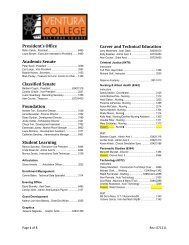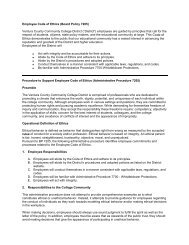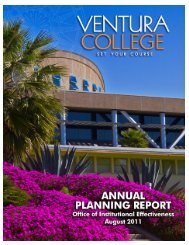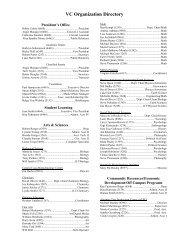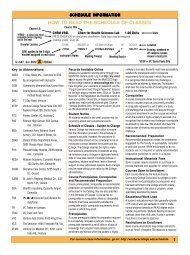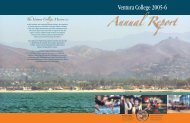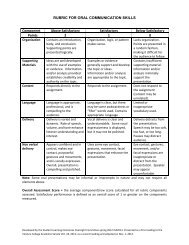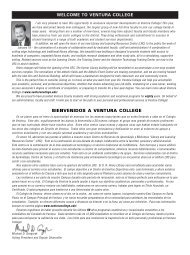2011 General CataloG & announCement of Courses - Ventura College
2011 General CataloG & announCement of Courses - Ventura College
2011 General CataloG & announCement of Courses - Ventura College
Create successful ePaper yourself
Turn your PDF publications into a flip-book with our unique Google optimized e-Paper software.
SRTK has its merits in that it attempts to provide a standardized<br />
measure <strong>of</strong> college effectiveness nationwide. However, in order to<br />
fully understand what SRTK rates mean for a college, one should<br />
also know its limitations. First, the cohort group can be quite<br />
small compared to the entire Community <strong>College</strong> population, and<br />
is therefore not fully representative <strong>of</strong> all educational activities<br />
at a college. Many Community <strong>College</strong>s do not have the primary<br />
mission <strong>of</strong> producing only transferable students. There can also be<br />
data collection issues involved in the acquisition <strong>of</strong> valid numbers<br />
used in deriving SRTK rates; since there is no central nationwide<br />
“clearinghouse” <strong>of</strong> transfer data, it is impossible to generate<br />
accurate transfer-out-rates.<br />
The “transfer rate” does not include any students who first<br />
completed a degree or certificate or became “transferred prepared”<br />
prior to transferring. The “completion rate” results for the 2005<br />
SRTK study described above was 26.58% for VC. The Statewide<br />
completion rate was 24.1%. The completion rate is the percent <strong>of</strong><br />
students from the group studied who attained a certificate or degree<br />
or became “transferred prepared” during a three year period from<br />
Fall 2005 to Spring 2008. Transfer-prepared was defined by the<br />
study as having completed 56 transferable units with a minimum<br />
GPA <strong>of</strong> 2.0.<br />
The transfer rate result for the SRTK study <strong>of</strong> <strong>Ventura</strong> <strong>College</strong><br />
described above was 17.30%. The Statewide Transfer rate was<br />
17.91%. Caution: the transfer rate does not count students who<br />
attained a certificate or degree prior to transferring to another<br />
post-secondary institution such as UC or CSU.<br />
<strong>General</strong> information about SRTK is available to the public through<br />
the Chancellor’s Office <strong>of</strong> the California Community <strong>College</strong> System<br />
website: cccco.edu/000/05index.htm. Specific information on<br />
the most recent cohort for <strong>Ventura</strong> <strong>College</strong> is available at srtk.<br />
cccco.edu/683/05index.htm.<br />
APPENDIX XI<br />
Policy on Harassment / Discrimination<br />
Complaint Procedure for Harassment /<br />
Discrimination<br />
Members <strong>of</strong> a college community−students, faculty,<br />
administrators, staff and visitors−must be able to study and work<br />
in an atmosphere <strong>of</strong> mutual respect and trust. <strong>Ventura</strong> County<br />
Community <strong>College</strong> District is actively committed to creating and<br />
maintaining an environment which respects the dignity <strong>of</strong> individuals<br />
and groups. The goal <strong>of</strong> <strong>Ventura</strong> County Community <strong>College</strong> District<br />
is to be sensitive to the needs <strong>of</strong> students, staff and those who<br />
interact with the college community, while preserving the rights<br />
<strong>of</strong> those against whom allegations have been made. Employees<br />
or students <strong>of</strong> the District who feel that they have been harassed<br />
or discriminated against based on race, color, national or ethnic<br />
origin, age, gender, religion, sexual orientation, veteran status,<br />
marital status or physical or mental disability have the right to file<br />
a complaint.<br />
The procedures outlined govern the process for all discrimination<br />
complaints filed by employees or students, including sexual<br />
harassment. Complaints may be filed: student against student,<br />
student against employee, employee against student, employee<br />
against employee, visitor against employee, employee against<br />
visitor, etc.<br />
Complaints must be filed with the District within one year <strong>of</strong><br />
the alleged harassment or discrimination or within one year <strong>of</strong> the<br />
date on which the Complainant knew or should have known <strong>of</strong> the<br />
facts <strong>of</strong> the alleged incident. District employees involved in any<br />
aspect <strong>of</strong> investigating or resolving a complaint <strong>of</strong> harassment or<br />
discrimination will have received training from a qualified source<br />
in advance <strong>of</strong> their service.<br />
Non-retaliation for filing−no individual will suffer retaliation as a<br />
result <strong>of</strong> filing a claim or being a witness in regard to harassment/<br />
discrimination allegations. Persons engaging in retaliation are<br />
subject to disciplinary action.<br />
Definitions:<br />
Complainant: An individual who believes that he/she has been<br />
the victim <strong>of</strong> harassment or discrimination.<br />
Respondent: An individual against whom a claim <strong>of</strong><br />
harassment or discrimination is made.<br />
Complaint: A written allegation that a student, staff<br />
member, or other individual who interacts with<br />
VCCCD has subjected someone to harassment<br />
or discrimination.<br />
Responsible<br />
District Officer: The person at the District who is responsible<br />
for coordinating the investigations <strong>of</strong> all<br />
harassment and discrimination complaints.<br />
The District has established the following procedures to resolve<br />
charges <strong>of</strong> harassment or discrimination.<br />
Informal Process<br />
An individual who has reason to believe that he or she has been<br />
a victim <strong>of</strong> harassment or discrimination based on race, color,<br />
national or ethnic origin, age, gender, religion, sexual orientation,<br />
marital status, veteran status or physical or mental disability<br />
may resolve the matter through an informal process under this<br />
procedure. Participation in the informal process is optional and<br />
not a prerequisite to filing a formal complaint.<br />
1. A person who believes that he or she has personally suffered<br />
harassment or discrimination should contact the appropriate<br />
Intake Facilitator at their location to directly discuss his or<br />
her concerns.<br />
2. The Intake Facilitator may inform the Respondent <strong>of</strong> the<br />
possible complaint and shall meet with the Complainant to:<br />
a. understand the nature <strong>of</strong> the concern;<br />
b. give to Complainant a copy <strong>of</strong> the District’s Sexual<br />
Harassment Policy brochure and this “Complaint<br />
Procedure for Harassment/Discrimination” document;<br />
c. inform Complainant <strong>of</strong> his or her rights under this<br />
complaint procedure;<br />
d. assist the Complainant in any way advisable.<br />
3. If the Complainant and the Respondent agree to a proposed<br />
resolution, the resolution shall be implemented and the<br />
informal process shall be concluded. At any time during<br />
the informal process, the Complainant may initiate a formal<br />
complaint.<br />
4. The Intake Facilitator shall keep a written log <strong>of</strong> discussions<br />
and a record <strong>of</strong> the resolution. This information shall become<br />
part <strong>of</strong> the <strong>of</strong>ficial investigation file if the Complainant initiates<br />
a formal complaint. If the parties reach a tentative agreement<br />
upon resolution <strong>of</strong> the complaint, a letter summarizing<br />
<strong>Ventura</strong> <strong>College</strong> Catalog 2010 - <strong>2011</strong> Appendices 241



